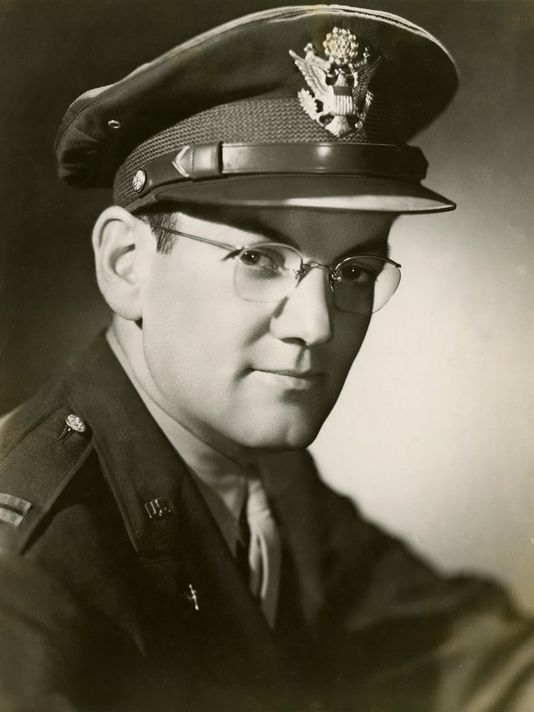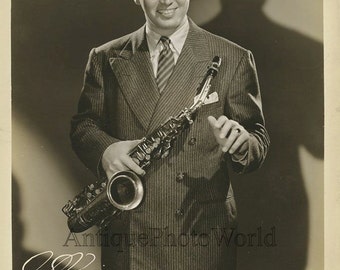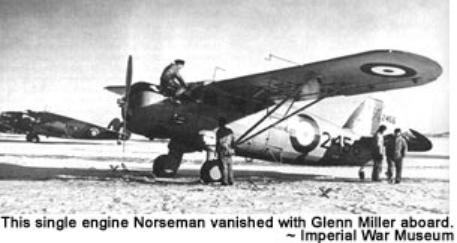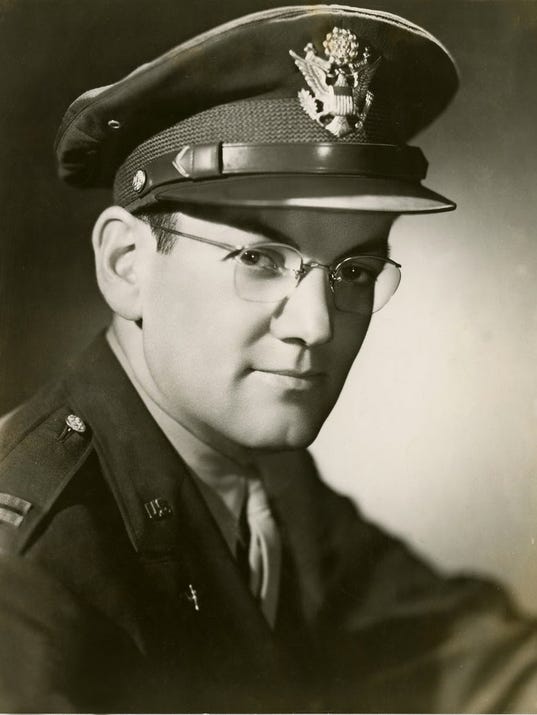
Major Glenn Miller 1944
Bernie Woods was the Music Editor of Variety during the Big Band Era. In that capacity he got to know all the bandleaders, singers and musicians. His 1994 memoir titled ‘When the Music Stopped’ pulls no punches when he discusses individuals, and he had little time for the legendary Glenn Miller. To quote Bernie, ‘Miller was a cold, calculating man very difficult to talk with, arrogant about the success of his band, dictatorial and utterly lacking in common courtesy.’ When we think of Jimmy Stewart’s portrayal of him in The Glenn Miller Story (1954), it is difficult to equate the two images. But movie biopics tend to do that more often than not.

June Allyson & James Stewart (R) in The Glenn Miller Story
Hal McIntyre played sax in Miller’s band and was his closest confidant. He related how the two would get together every few months and select which of their musicians was to be fired. The firing had little to do with the unlucky man’s ability or performance. It was merely Miller’s way of keeping his men in fear! It was a tremendous blow to the victim. But the others remembered. The 1954 biopic bears little resemblance to the man or the band’s history if we can believe those who once knew him. Jimmy Stewart (and June Allyson) are simply too nice to be true. But then Jimmy and June usually were in their pictures.

Hal McIntryre
Miller may possibly have contributed to his own death, or so his manager Don Haynes confided to Bernie Woods in 1949. Initially, Haynes was supposed to accompany Miller to Paris, but when Lt. Col. Norman Baessell offered the bandleader a seat in his plane (to be flown by Flight Officer John Morgan), Miller accepted and Haynes was fortuitously left behind. The trio were scheduled to take off for Paris late in the morning of 15 December 1944 but, according to Haynes, they spent the previous evening on a pub crawl and playing cards. Concerned about the weather, he personally rang to find out if the flight was still on. Then he sat with Miller and Baessell in the car at the airfield awaiting the arrival of Morgan and the plane. They were warned at length about the atrocious weather over the Channel, but Baessell and Miller, both possibly a little worse for wear, apparently pulled rank. The trio took off and were never seen again.

The flight was expected to take about two hours. Morgan was required to follow a specific air transport route called the SHAEF Corridor, passing over navigation waypoints at Maidenhead and Beachy Head, then across the Channel to a French waypoint at Fecamp, before eventually landing at AAF Villacoublay just south of Paris. The Royal Observation Corps at Beachy Head spotted the Norseman headed out over the water, precisely on course and on schedule at 14.37, just an hour before it was due to touch down near Paris.
In recent years an RAF navigator’s log has emerged that may shed light on what happened. The log records the crew of a Lancaster bomber spotting a light plane below them on its way to France. The bomber crews were headed home after aborting a raid over Germany because of poor visibility. As per standard operational procedure, those aircraft returning with un-dropped ordinance were required to ditch their bombs into the Channel. The designated drop zone was called South Jettison Drop Zone and was located south of Beachy Head. The log states that the light plane was directly beneath them when the bombs were dropped.
Navigator Fred Shaw told the story in several television documentaries. ‘As I was watching, the bomb aimer he said, ‘there is a kite down there’, Fred recalled. ‘And I looked down and saw a small, tiny, high wing monoplane…I saw him flip over to port. He looked like he was going into a spin, he dived in and splash (sic), then he disappeared under the wing.’ The captain of Shaw’s plane, Victor Gregory, confirmed that Shaw and two others reported over the intercom that they watched the plane go down. Because their mission had been scrubbed, however, the crew was not debriefed and no report on the downed plane was recorded.
The problem with this theory is that USAAF records clearly state that returning bombers were not in that area at that time. But there is one more twist to that. They were operating on local time and the RAF were using Greenwich Meantime (GMT). Evidently, the times did, in truth, check out after all. It is still worth noting that Miller, Baesell and Morgan were flying at a time when they had been clearly warned not to. Of course, the possibility still exists that another plane had seen the Norseman below it and had bombed it by mistake, thinking it was an enemy aircraft. In 2008, another man who was aboard a Lancaster that day, Ron Brown, strongly dismissed Shaw’s story. ‘Considering that we were jettisoning from an altitude of 3,000 feet, with almost nil visibility’, he scoffed, ‘in my opinion it was a ridiculous claim from any observer.’ So, who do we believe?
Over the succeeding decades there have been all kinds of outlandish theories to explain Miller’s disappearance, most of them fuelled by the US Military not announcing his disappearance until nine days after the aircraft vanished. The absence of a body further fuelled conspiracy theories. Some said he was found dead from a heart attack in a Paris brothel. Others claimed he died participating in a secret plot to overthrow Hitler, a plot that involved working undercover with David Niven, no less! There were even those who believed he was secretly returned to the United States, gravely ill, but still alive. None of these scenarios can be supported with solid evidence.
For what it is worth, in 1983 Miller’s own brother, Herb, stated that his famous brother died from lung cancer in 1945. The plane crash scenario was Glenn’s own idea, said Herb, because he wanted to die a hero’s death. Two years later a British diver named Clive Ward claimed to have found the remains of the Norseman off the coast of France. He found no sign of human remains, he said. However, he also found no sign of the aircraft’s registration number, so we are none the wiser really.

Herb Miller
There is another more recent explanation, one that paints Miller as a super patriot, eager to get to France as quickly as possible in spite of his known dread of flying. A 2014 television program: ‘History Detectives Special Investigations: The Disappearance of Glenn Miller’, argues that he realised the weather was atrocious but decided he owed it to his country to get to the French coast post haste because he was needed to boost the morale of the troops with his music. If that meant sacrificing his life – then so be it. Uh-huh. Miller was in his late thirties and, therefore, unlikely to be drafted, yet he joined the Armed Forces of his own free will, which all sounds very patriotic. However, there was every possibility that he might lose most of his younger, unmarried musicians to the draft anyway. By joining up he could keep his band together and still perform. He may simply have weighed his options and made the best of a tricky situation.
In conclusion, given the recent ‘local time/GMT’ explanation, I am inclined to think that the Norseman may have been bombed by mistake by the returning bombers, possibly observed through a small break in the cloud cover by Shaw and his fellow crew members. Or the plane’s instruments or wings might have iced up and/or the pilot became disoriented, causing it to plummet into the Channel. Whatever happened, the fact remains that the world lost a wonderful entertainer in his 40th year. Far too soon.


I’m a little late to discover this website but I’m finding it interesting. My parents had a Glen Miller album, can’t recall the name, I loved listening to it as a teenager, still recall some of the songs (I’ve Got a Gal in Kalamazoo, It Happened in Sun Valley, Chattanooga Choo Choo). The cause of Glen’s death will probably never be known, but I recall reading an article online about it a few years ago, something concerning either Glen Miller or unsolved mysteries–something like that–and someone made a comment on it, saying that Glen Miller did make it to Paris, but he had a married girlfriend there whose husband just happened to be a cop–and this man caught his wife & Glen together (not knowing who Glen was) and shot him. The Army found out about it, decided if the truth were ever known it would hurt a lot of people (morale-wise), and in figuring out how to hide the murder, the Army put Miller’s name on the passenger manifest of a plane that disappeared over the English Channel a short time later & his body was disposed of by the Army. The person who posted this gave the impression that he knew someone who was involved with this cover-up back in 1944. True or not, an interesting story!
Thank you for your intriguing story, Wendy. I have looked at several explanations for his death, but that is a new one on me. Of course, like the others, it may well be true, but the chances of definitive proof turning up at this late stage must surely be miniscule. One wonders, however, if the Army would go to all that trouble for so little return. Morale was surely dented by his death regardless of the cause. Would murder compared to air crash have made much difference? Intriguing nonetheless. Whenever someone famous dies mysteriously the conspiracy tales abound. I have no doubt that the occasional one hits the mark. This could be one of them, not that we will probably ever know for sure. Thanks again for taking the time to write me about it. Much appreciated.
The Norseman was found in a salvage yard in 1947 (the serial numbers matched). There was no flight, no crash.
Most interesting. Thank you, Alben. I did not know that.
I still don’t.
Excellent overview.
Thank you, Brad. Kind of you to say so.